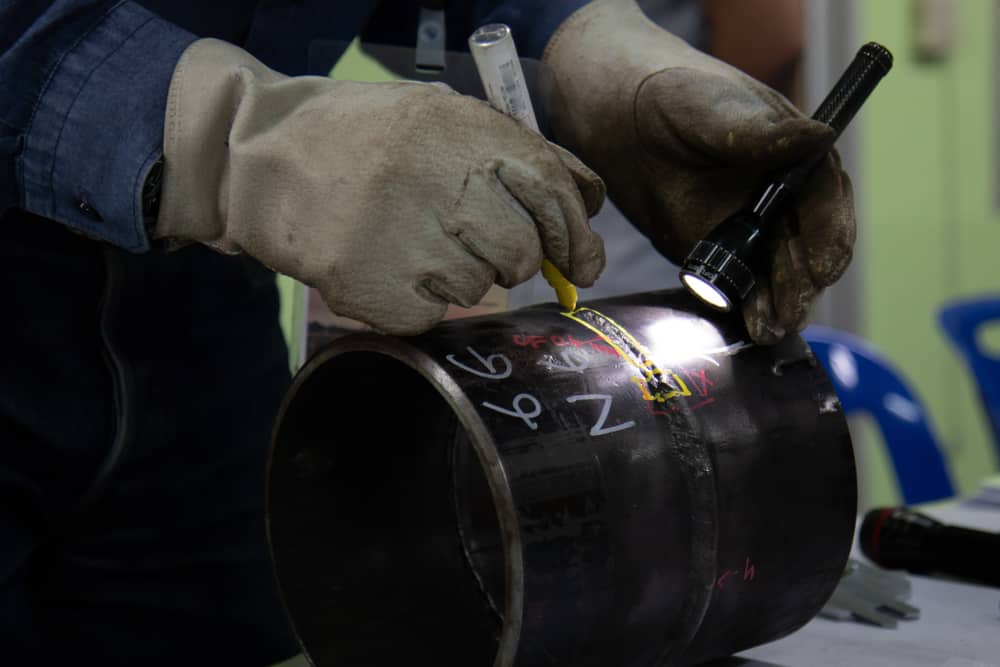Comprehensive Introduction of Pipe Welding Examination Treatments
Pipe welding assessment procedures play an essential duty in ensuring that bonded connections meet rigorous market standards and requirements. From thorough pre-welding inspections to extensive post-weld assessments, a distinct evaluation procedure is vital for maintaining the architectural stability of pipelines.
Pre-welding Examination Preparations
Prior to commencing the welding procedure, complete pre-welding assessment preparations are important to make certain the honesty and high quality of the weld joint. These preparations involve a thorough assessment of the products to be bonded, the welding devices, and the work setting. By carrying out comprehensive pre-welding evaluation prep work, potential concerns can be identified and settled early on, leading to dependable and top notch weld joints.
Welding Procedure Qualification
Detailed pre-welding assessment preparations lay the structure for the crucial procedure of Welding Procedure Credentials, making sure the integrity and high quality of the weld joint. Welding Procedure Credentials (WPQ) is an important action in the welding process that includes screening and accrediting welding procedures to assure they satisfy details standards and demands. The WPQ procedure usually consists of welding procedure spec growth, welding procedure credentials testing, and paperwork of the outcomes.
Throughout welding procedure spec development, necessary information such as the welding process, welding materials, joint style, and welding criteria are defined to produce a thorough treatment. Subsequently, welding procedure credentials screening is performed to validate the recommended procedure's integrity. This screening typically entails welding examination promo codes that are subjected to different mechanical and non-destructive tests to examine the weld's quality and adherence to the specified criteria.
In-process Weld Inspection
During the welding process, in-process weld assessment plays an essential role in making sure the high quality and stability of the weld joint - Pipeline Welding Inspection. This kind of assessment entails checking the welding criteria, assessing the weld bead development, and detecting any potential flaws or suspensions as they occur. By conducting in-process weld inspections, welding drivers can without delay resolve any kind of concerns that might develop, thus avoiding more issues and guaranteeing that the final weld satisfies the required requirements
Usual techniques used for in-process weld inspection consist of aesthetic inspection, fluid penetrant testing, magnetic particle testing, ultrasonic screening, and radiographic testing. Aesthetic assessment is usually the initial step while doing so, permitting examiners to aesthetically analyze the weld for surface irregularities such as fractures, porosity, or incomplete blend. Advanced approaches like ultrasonic testing and radiographic screening offer thorough insights right into the internal framework of the weld, guaranteeing that there are no hidden flaws that could jeopardize the weld joint's strength and stability. On see the whole, in-process weld assessment is vital for maintaining the high quality and reliability of welded pipes.
Non-destructive Testing (NDT)
Non-destructive Testing (NDT) is an essential method utilized in pipe welding inspection to evaluate the honesty of weld joints without creating damage to the welded structure. By using different NDT strategies, inspectors can evaluate the quality of welds and determine any type of flaws or discontinuities that may compromise the structural stability of the pipe. Typical NDT approaches used in pipeline welding inspection include Radiographic Testing (RT), Ultrasonic Testing (UT), Magnetic Fragment Testing (MPT), Liquid Penetrant Screening (LPT), and Visual Screening (VT)
RT involves using X-rays or gamma rays to create photos of the internal framework of the weld, permitting assessors to identify problems such as porosity, fractures, or incomplete fusion. UT uses high-frequency sound waves to detect flaws beneath the surface area of the weld, read more supplying thorough details regarding the size and location of defects. MPT and LPT are used to recognize surface-breaking flaws by applying penetrant fluids or magnetic particles to the weld area. Additionally, VT entails visual evaluation of welds to determine any type of visible flaws.
Post-weld Examination and Paperwork


Documents of post-weld assessment findings is necessary for maintaining top quality control records and ensuring compliance with sector standards and laws. Comprehensive records must consist of information regarding the inspection techniques made use of, the location and nature of any kind of defects discovered, and any kind of corrective actions taken - Pipeline Welding Inspection. Proper paperwork not only works as a document of the weld's top quality however likewise help in future maintenance and evaluation procedures
Final Thought

In verdict, pipe welding examination treatments play an important function in making certain the top quality and honesty of welds. On the whole, adherence to correct examination methods is key to the success of pipe welding tasks.
From thorough pre-welding examinations to thorough post-weld assessments, a well-defined inspection process is essential for keeping the architectural strength of pipes. By carrying out in-process weld assessments, welding operators can promptly address any kind of concerns that might develop, thus making certain and protecting against additional problems that the final weld meets the needed specs.
Common approaches utilized for in-process weld assessment include aesthetic inspection, fluid penetrant testing, magnetic particle screening, ultrasonic testing, and radiographic screening.Non-destructive Testing (NDT) is a vital method utilized in pipeline welding assessment to evaluate the honesty of weld joints without creating damage to the bonded structure. Post-weld examination includes numerous methods to assess the welds for flaws, including aesthetic inspection, color penetrant testing, magnetic particle screening, ultrasonic testing, and radiographic screening.